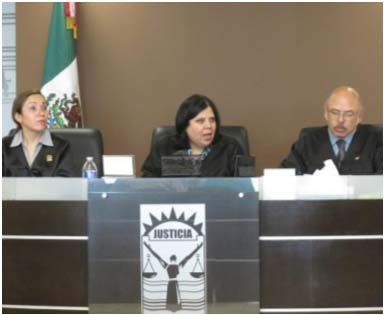
Judge Ana María Elías-González at work in her courtroom in Baja California, Mexico.
USAID/Mexico Justice and Security Program
Training helps law officials reach the highest standards
“We have debates about real cases .... It’s a unique way of forming the criteria that we need to work with the new system.”
On a sunny day in December 2012, Judge Ana María Elías-González walked into a Baja California state courtroom to give the final reading of a 35-year prison sentence she handed to a man a few days previously for the murder of his girlfriend.
The judge would have been excused for showing a few nerves. The case, which lasted two months with almost daily court hearings, had attracted plenty of media attention and was the talk of the town. It was also the highest profile murder trial to take place under the state’s nascent adversarial justice system, part of Mexico’s profound shift from a closed, inquisitorial model to a new and more transparent model.
But as the courtroom clock passed 12:00 p.m., Elías-González showed no nerves at all. Instead, in front of defense and prosecution teams as well as local press and spectators, she deliberated with authority and precision. In all, the hearing took just seven minutes.
Elías-González says that much of that self-assurance is thanks to USAID-sponsored training. Prior to the introduction of the new justice system in Baja California less than three years ago, she and other judges took intensive courses to get a firm grip on the theoretical underpinnings of the adversarial model. The judges were trained in a raft of new secondary laws at the state level as well as the extensive use of alternative justice mechanisms such as plea bargaining, mediation and conciliation to free up the courts for the most important cases.
“For three months, we dropped everything and dedicated all of our time to studying,” she recalls.
The change to the new system was a revolution for Elías-González and an upheaval in working practice. Judges now play a more active role in proceedings, acting as a sort of moderator and arbiter rolled into one. Under the old system, by contrast, judges would often play a very passive role, merely signing off on the prosecutors’ written statement.
Judges must now always be present in hearings. Previously, they would usually send their clerks instead. Also, judges now hear all evidence in a courtroom with both the defense and prosecution present. Victims and witnesses give live testimony, with each side able to cross-examine.
“We ruled on cases based on paper and documents and were not really in touch with the accused or the victim,” says Elías-González. “It was typical not to have any contact with the witnesses, not to know the victims, and it was even possible to sentence someone without ever having seen them.”
The training helped judges such as Elías-González become familiar with these radically different working practices, providing her and others with the chance to simulate courtroom situations to become fully familiarized with the procedural aspects of the new system. As of September 2012, 59 judges in the state have received the training.
As part of her training, Elías-González traveled to Puerto Rico with nine other Mexican judges in May 2012. During the following two weeks, she and her colleagues received expert tuition in Spanish from professors of two universities on issues such as ethics, comparative law and the rules pertaining to evidence.
“It underscored my knowledge of the adversarial model, and greatly expanded my understanding of the logic that lies at its heart,” she says. “After that training, I became much more direct in my approach, without unnecessary twists and turns, and going straight to the pertinent information.”
Elías-González says that the new system, and her ability to successfully overcome the retraining challenges that it poses, have made justice in Mexico much more transparent and reliable. It has also made her own job much more fulfilling, she says.
Indeed, her first day as a judge back in 1999 when she was 35 years old was a far cry from the image she had conjured when, as a school girl, she had first entertained the idea of working in law. “Back then, I imagined exactly what I am doing now,” she recalls. “I never imagined the tribunal brimming with cases that I walked into that day.”
Now with more than two years of experience in the new system, Elías-González has been passing on her knowledge to her fellow judges through USAID’s “Train-the-Trainer” courses. She says the courses she provides on the new system are a way of maximizing the benefits for Mexico of the training she has received so far. But she also says that the courses she took provided an opportunity to discuss the details and subtleties of Mexico’s new system with colleagues and, above all, with the experts that teach the courses.
“We have debates about real cases that we have and bounce ideas around with the person who gives the course,” she explains. “It’s a unique way of forming the criteria that we need to work with the new system.”
In Baja California, the results are already on display. As she says of the murder trial that concluded in December, and in which more than 60 witnesses participated, “It was a great experience. I thought we were going to have to wait a lot longer before seeing such a high degree of professionalism from all of those involved."
These activities were supported through USAID/Mexico's Justice and Security Program, implemented by Management Systems International. The program, which runs from July 2009-December 2013, works with the Government of Mexico to reform criminal justice at the state and federal levels through legislation, institutions and civil society organizations. The seven Mexican priority states where USAID is supporting justice sector activities are Baja California, Chihuahua, Nuevo Leon, Oaxaca, Morelos, Hidalgo and Puebla.
File Attachment







Comment
Make a general inquiry or suggest an improvement.